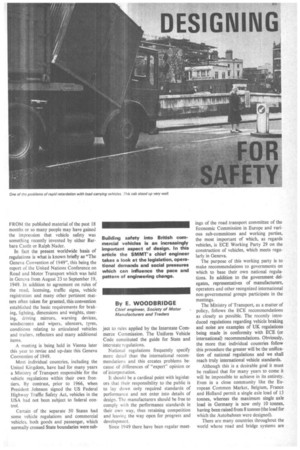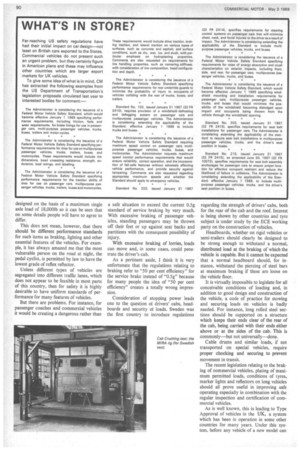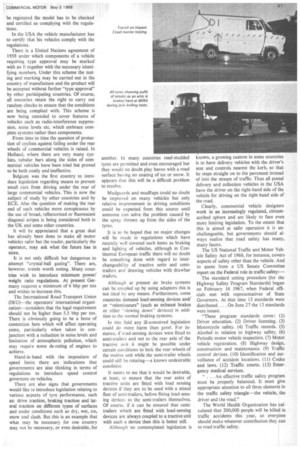By E. WOODBRIDGE
Page 91

Page 92

Page 93

If you've noticed an error in this article please click here to report it so we can fix it.
Chief engineer, Society of Motor Manufacturers and Traders
Building safety into British commercial vehicles is an increasingly important aspect of design. In this article the SMMT's chief engineer takes a look at the legislation, operational demands and social pressures which can influence the pace and pattern of engineering change.
FROM the published material of the past 18 months or so many people may have gained the impression that vehicle safety was something recently invented by either Barbara Castle or Ralph Nader.
In fact the present worldwide basis of regulations is what is known briefly as "The Geneva Convention of 1949", this being the report of the United Nations Conference on Road and Motor Transport which was held in Geneva from August 23 to September 19, 1949. In addition to agreement on rules of the road, licensing, traffic signs, vehicle registration and many other pertinent matters often taken for granted, this convention established the basic requirements for braking, lighting, dimensions and weights, steering, driving mirrors, warning devices, windscreens and wipers, silencers, tyres, conditions relating to articulated vehicles and trailers, reflectors and many additional items.
A meeting is being held in Vienna later this year to revise and up-date this Geneva Convention of 1949.
Most individual countries, including the United Kingdom, have had for many years a Ministry of Transport responsible for the vehicle regulations within their own frontiers. By contrast, prior to 1966, when President Johnson signed the US Federal Highway Traffic Safety Act, vehicles in the USA had not been subject to federal control.
Certain of the separate 50 States had some vehicle regulations and commercial vehicles, both goods and passenger, which normally crossed State boundaries were sub ject to rules applied by the Interstate Commerce Commission. The Uniform Vehicle Code constituted the guide for State and inter state regulations.
National regulations frequently specify more detail than the international recommendations and this creates problems because of differences of "expert" opinion or of interpret ation.
It should be a cardinal point with legislators that their responsibility to the public is to lay down only required standards of performance and not enter into details of design. The manufacturers should be free to comply with the performance standards in their own way, thus retaining competition and leaving the way open for progress and development.
Since 1949 there have been regular meet
ings of the road transport committee of the Economic Commission in Europe and various sub-committees and working parties, the most important of which, as regards vehicles, is ECE Working Party 29 on the construction of vehicles, which meets regularly in Geneva.
The purpose of this working party is to make recommendations to governments on which to base their own national regulations. In addition to the government delegates, representatives of manufacturers, operators and other recognized international non-governmental groups participate in the meetings.
The Ministry of Transport, as a matter of policy, follows the ECE recommendations as closely as possible. The recently introduced regulations regarding vehicle braking and noise are examples of UK regulations being made in conformity with ECE (or international) recommendations. Obviously, the more that individual countries follow this procedure the greater will be the unification of national regulations and we shall reach truly international vehicle standards.
Although this is a desirable goal it must be realized that for many years to come it will be impossible to achieve in its entirety. Even in a close community like the European Common Market, Belgium, France and Holland permit a single axle load of 13 tonnes, whereas the maximum single axle load in Germany is now only 10 tonnes, having been raised from 8 tonnes (the load for which the Autobahnen were designed).
There are many countries throughout the world whose road and bridge systems are designed on the basis of a maximum single axle load of 18,000lb so it can be seen that on some details people will have to agree to differ.
This does not mean, however, that there should be different performance standards for such items as braking, lighting and other essential features of the vehicles. For example, it has always amazed me that the most vulnerable person on the road at night, the pedal cyclist, is permitted by law to have the lowest grade of reflex reflector.
Unless different types of vehicles are segregated into different traffic lanes, which does not appear to be feasible in most parts of this country, then for safety it is highly desirable to have uniform standards of performance for many features of vehicles.
But there are problems. For instance, for passenger coaches and commercial vehicles it would be creating a dangerous rather than a safe situation to exceed the current 0.5g standard of service braking by very much. With excessive braking of passenger vehicles, standing passengers may be thrown off their feet or up against seat backs and partitions with the consequent possibility of injury.
With excessive braking of lorries, loads can move and, in some cases, could penetrate the driver's cab.
As a pertinent aside, I think it is very unfortunate that the regulations relating to braking refer to "50 per cent efficiency" for the service brake instead of "0.5g" because for many people the idea of "50 per cent efficiency" creates a totally wrong impression.
Consideration of stopping power leads one to the question of drivers' cabs, headboards and security of loads. Sweden was the first country to introduce regulations regarding the strength of drivers' cabs, both for the rear of the cab and the roof. Interest is being shown by other countries and tyre subject is under study by the ECE working party on the construction of vehicles.
Headboards, whether on rigid vehicles or semi-trailers should clearly be designed to be strong enough to withstand a normal, distributed load at the braking of which the vehicle is capable. But it cannot be expected that a normal headboard should, for instance, withstand the piercing of steel bars at maximum braking if these are loose on the vehicle floor.
It is virtually impossible to legislate for all conceivable conditions of loading and, in addition to good design and construction of the vehicle, a code of practice for stowing and securing loads on vehicles is badly needed. For instance, long rolled steel sections should be supported on a structure which keeps their ends clear of the rear of the cab, being carried with their ends either above or at the sides of the cab. This is commonly—but not universally—done.
Cable drums and similar loads, if not transported on special vehicles, require proper chocking and securing to prevent movement in transit.
The recent legislation relating to the braking of commercial vehicles, plating of maximum permitted loads, conditions of' tyres, marker lights and reflectors on long vehicles should all prove useful in improving safe operating especially in combination with the regular inspection and certification of commercial vehicles.
As is well known, this is leading to Type Approval of vehicles in the UK, a system which has been in operation in some other countries for many years. Under this system, before any vehicle of a new model can be registered the model has to be checked and certified as complying with the regulations.
In the USA the vehicle manufacturer has to certify that his vehicles comply with the regulations.
There is a United Nations agreement of 1958 under which components of a vehicle requiring type approval may be marked with an E together with the necessary identifying numbers. Under this scheme the test ing and marking may be carried out in the country of manufacture and the product will be accepted without further "type approval" by other participating countries. Of course, all countries retain the right to carry out random checks to ensure that the conditions are being complied with. This scheme is now being extended to cover features of vehicles such as radio-interference suppression, noise levels etc. which embrace complete systems rather than components.
From time to time the question of protection of cyclists against falling under the rear wheels of commercial vehicles is raised, In Holland, where there are very many cyclists, tubular bars along the sides of commercial vehicles have been tried but proved to be both costly and ineffective.
Belgium was the first country to introduce legislation regarding means to prevent small cars from driving under the rear of large commercial vehicles. This is now the subject of study by other countries and by ECE. Also the question of making the rear end of such vehicles more conspicuous by the use of broad, reflectorized or fluorescent diagonal stripes is being considered both in the UK and some other countries.
It will be appreciated that a great deal has already been done to make all motor vehicles safer but the reader, particularly the operator, may ask what the future has in store.
It is not only difficult but dangerous to attempt "crystal-ball gazing". There are, however, trends worth noting. Many countries wish to introduce minimum power/ weight ratio regulations. At present Germany requires a minimum of 6 bhp per ton and wishes to increase this.
The International Road Transport Union (IRU)—the operators' international organi zation—considers that the legal requirement should not be higher than 5.5 bhp per ton. There is obviously going to be a bone of contention here which will affect operating costs, particularly when taken in conjunction with a reduction in noise levels and limitation of atmospheric pollution, which may require some de-rating of engines to achieve.
Hand-in-hand with the imposition of speed limits there are indications that governments are also thinking in terms of regulations to introduce speed control governors on vehicles.
There are also signs that governments would like to introduce legislation relating to various aspects of tyre performance, such as: drive traction, braking traction and lateral traction on different types of surfaces and under conditions such as dry, wet, ice, snow and slush. But this is an example that what may be necessary for one country may not be necessary, or even desirable, for another. In many countries steel-studded tyres are permitted and even encouraged but they would no doubt play havoc with a road surface having no coating of ice or snow. It appears that this will be a difficult problem to resolve.
Mudguards and mudflaps could no doubt be improved on many vehicles but only relative improvement to driving conditions could be expected from this source until someone can solve the problem caused by the spray thrown up from the sides of the tyres.
It is to be hoped that no major changes will be made in regulations which have recently well covered such items as braking and lighting of vehicles, although in Continental European traffic there will no doubt be something done with regard to interchangeability of tractive units and semitrailers and drawing vehicles with drawbar trailers.
Although at present air brake systems can be coupled up by using adaptors this is not ideal by any means. Furthermore, some countries demand load-sensing devices and/ or "relentisseurs" (such as exhaust brakes or other "slowing down" devices) in addition to the normal braking systems.
In this field any ill-conceived legislation could do more harm than good. For instance, if load-sensing devices were fitted to semi-trailers and not to the rear axle of the tractive unit it might be possible under certain conditions to lock the rear wheels of the motive unit while the semi-trailer wheels could still be rotating—a known undesirable condition.
It seems to me that it would be desirable, at least, to ensure that the rear axles of tractive units are fitted with load sensing devices if they are to be used with a mixed fleet of semi-trailers, before fitting load-sensing devices to the semi-trailers themselves. Of course, if it can be ensured that semitrailers which are fitted with load-sensing devices are always coupled to a tractive unit with such a device then this is better still.
Although no contemplated legislation is known, a growing custom in some countries is to have delivery vehicles with the driver's seat and controls nearest the kerb, so that he steps straight on to the pavement instead of into the stream of traffic. Thus all postal delivery and collection vehicles in the USA have the driver on the right-hand side of the vehicle for driving on the right-hand side of the road.
Clearly, commercial vehicle designers work in an increasingly regulated, circum scribed sphere and are likely to face even more limiting legislation. To the extent that this is aimed at safer operation it is un challengeable, but governments should always realize that road safety has many, many facets.
The US National Traffic and Motor Vehicle Safety Act of 1966, for instance, covers aspects of safety other than the vehicle. And to quote from a US Senate Committee report on the Federal role in traffic safety:— The standard setting procedure (for the Highway Safety Program Standards) began on February 16 1967, when Federal officials met with representatives of State Governors. At that time 13 standards were distributed. ... On June 27 the 13 standards were issued.
"These program standards cover: (1) Driver education. (2) Driver licensing. (3) Motorcycle safety. (4) Traffic records. (5) Alcohol in relation to highway safety. (6) Periodic motor vehicle inspection. (7) Motor vehicle registration. (8) Highway design, construction and maintenance. (9) Traffic control devices. (10) Identification and sur veillance of accident locations. (11) Codes and laws. (12) Traffic courts. (13) Emergency medical services.
" . An effective traffic safety program must be properly balanced. It must give appropriate attention to all three elements in the traffic safety triangle—the vehicle, the driver and the road."
The World Health Organization has calculated that 200,000 people will be killed in traffic accidents this year, so everyone should make whatever contribution they can to road traffic safety.




































































































































































































































